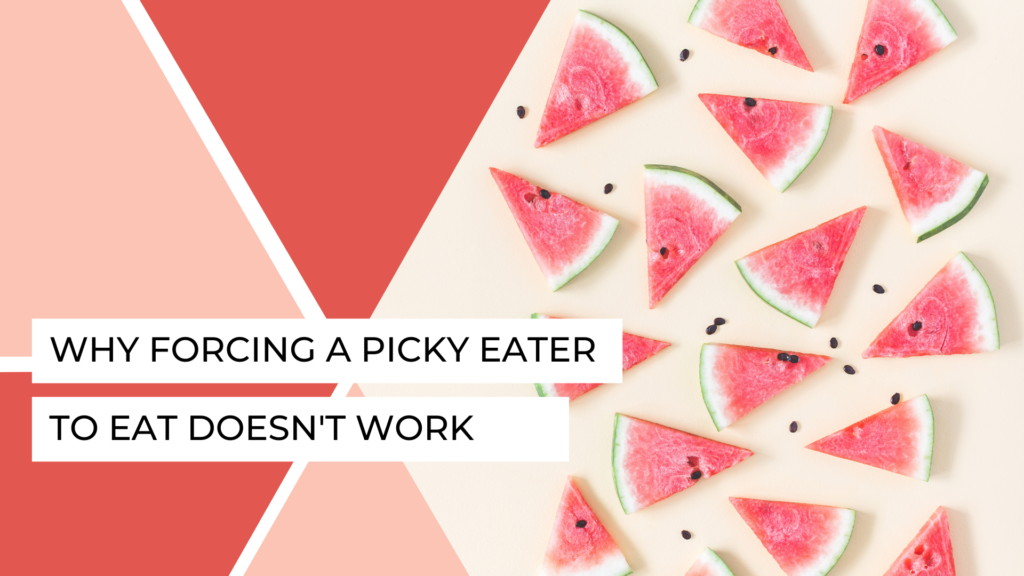This article discusses why forcing picky eaters to eat doesn’t help them try new food and provides 3 alternatives to forcing, pressuring, and requiring a child to eat a new food.

Many of us grew up with our parents forcing healthy food. Whether we were told we had to finish our salad in order to later have dessert or take three bites of brussels sprouts before leaving the table, the pressure was on.
Forcing a child to eat is something many parents of picky eaters struggle with. Often it feels like there is no other option. They don’t know how else to get a child eat.
Is it okay to force your child to try a new food and eat healthy foods?
Forcing Picky Eaters Doesn’t Help Picky Eating
According to research, the answer is no. In fact, pressuring a child to eat is associated with lower weight, lower food intake, and increased picky eating.
Eating experiences during childhood may affect a child’s relationship with food for the rest of their lives.
A 2015 study surveyed college students and their parents about childhood eating habits and parental feeding styles. Researchers found that parental pressure during mealtimes was associated with disordered eating patterns in young adulthood. Interestingly, picky eating alone was not associated with these disordered eating patterns. This means that a picky eater who was not pressured by their parents to eat had no association with disordered eating later in life.
Forcing Kids to Eat Can Make Picky Eating Worse
Feeling pressure to eat as a child is associated with picky eating that lasts into adult years and pressuring children to eat specific foods can have the opposite of the intended effect.
A 2006 experiment looked at two groups of preschoolers. Each group was encouraged to eat a particular soup, though the children were ultimately allowed to make their own choice about what they ate. Researchers found that the children consistently selected the soup they were not asked to eat and that they also made fewer negative comments about that option.
While it’s ultimately not effective to force kids to eat new or non-preferred foods, we also know that repeated exposure to new or disliked foods is key to increasing acceptance. Ideally, repeated exposure is done in a fun, no-pressure environment.

3 Alternatives to Forcing Picky Eaters to Eat
Use “Can” Phrases
Rather than forcing your child to take a bite, empower your child with a “can phrase”. This could be something simple to increase their comfort level around the food: “You can poke it with your fork” or “You can pass it to me.” If they are ready, try something a little more challenging: “You can hold it in your hand to see how heavy it is” or “You can squish it between your fingers.” These “can phrases” are empowering suggestions that invite your child to interact with new foods in a way that can help them work up to eating.
Regularly Offer New Foods
Make sure you’re always serving new new foods at meals. Give your child an open invitation to eat, but don’t pressure them to taste if they’re not ready yet.
If your extremely picky eater is uncomfortable having a new food on their plate, you can designate a plate for exploration and assure your child that they don’t have to eat it if they’re not ready yet.
Be sure that you’re eating these foods at mealtimes with your child. This behavior modeling, especially when part of a family meal, can help picky eaters feel more comfortable trying new foods on their own!
Pair New and Preferred Foods
I worked with a child who loved crackers. He paired them with any new food that he tried, even if it was an unconventional pairing. Offering a new food alongside a preferred food can make the new food seem less intimidating. For example, if there is a dip that your child likes, offer it with the vegetable your family is having for dinner. The preferred food acts as a vehicle for the new food, masking its taste and texture while still increasing exposure.
Recap
Every parent wants their child to be healthy, and eating nutritious food is a big part of that. Though it might be tempting, resist the urge to use a no-nonsense method of forcing your child to eat. Research suggests that it may do more harm than good. Instead, continue to offer foods to increase exposure, but let your child decide whether and how much to eat.
Homework
Take a moment to reflect on your expectations when it comes to your child’s eating and how you might present those expectations, verbally or non-verbally. Consider one of the three suggested alternatives to try at your next family meal.
Looking for more easy solutions to help your child try new foods? Join my FREE email series: 5 Steps to Help Your Picky Eater Learn to Try New Foods and Add Variety


I have 3 levels of picky eaters, 2 are normal picky but the 3rd borders on food aversion complete with gaging and skipping meals. How do I work with that? At this point, I insist he takes a bite of the new food I put on his plate. If I don’t he won’t ever eat it. Also, I don’t allow dessert if he doesn’t eat what is on his plate, so pretty much exactly opposite of these suggestions! I surely need the help.
Hi Sam, I wonder if you’ve made any changes since reading this article and if so how they helped